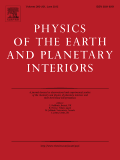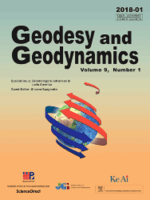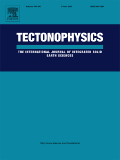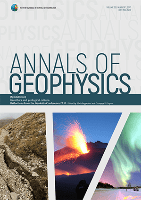
PHYSICS OF THE EARTH AND PLANETARY INTERIORS
Scope & Guideline
Exploring the Mysteries of Earth and Beyond
Introduction
Aims and Scopes
- Geophysical Processes:
Research on the physical processes governing the behavior of the Earth and other planetary bodies, including seismic activity, mantle dynamics, and core-mantle interactions. - Paleomagnetism and Magnetic Field Studies:
Investigations into the Earth's magnetic field variations over geologic time, including studies of paleomagnetic secular variation and geomagnetic excursions. - Seismic Imaging and Tomography:
Utilization of seismic data to create detailed images of the Earth's interior structure, focusing on crustal and mantle characteristics through advanced tomography techniques. - Volcanology and Geodynamics:
Exploration of volcanic processes, including magma dynamics and the interplay between tectonics and volcanic activity, alongside studies of lithospheric deformation. - Material Properties Under Extreme Conditions:
Examination of mineral behavior and properties under high-pressure and high-temperature conditions relevant to the Earth's interior, including phase transitions and elasticity. - Machine Learning and Data-Driven Approaches:
Application of machine learning techniques to geophysical data for improved modeling, analysis, and prediction of geological phenomena.
Trending and Emerging
- Machine Learning Applications:
An increasing number of studies are employing machine learning techniques to analyze seismic data and improve predictive modeling, reflecting a broader trend towards data-driven research methodologies. - Advanced Seismic Tomography:
There is a growing emphasis on high-resolution seismic tomography, utilizing innovative techniques to better understand the complex structures within the Earth's crust and mantle. - Interactions Between Tectonics and Volcanism:
Research exploring the connections between tectonic activity and volcanic processes is gaining traction, highlighting the dynamic nature of Earth’s geological systems. - Fluid Dynamics in Earth Processes:
Studies focusing on the role of fluids in geological processes, such as magma ascent and hydrothermal circulation, are becoming increasingly common, indicating a shift towards understanding dynamic interactions. - Impacts of Climate on Geological Processes:
Emerging research is beginning to address the influence of climate change on geological phenomena, including landslide susceptibility and glacial dynamics, reflecting interdisciplinary approaches to Earth sciences.
Declining or Waning
- Traditional Geomagnetic Studies:
While geomagnetic studies remain important, there has been a noticeable shift away from traditional methods towards more innovative approaches such as machine learning and data assimilation techniques. - Static Earth Models:
Research focused on static models of the Earth's structure has become less prominent, as dynamic models that incorporate fluid dynamics and time-dependent processes gain favor. - Regional Seismology with Limited Scope:
There has been a decrease in studies that focus narrowly on regional seismology without broader implications or connections to global tectonic processes. - Simplistic Mineral Property Models:
Research relying on overly simplistic models of mineral properties under extreme conditions is waning, with a trend towards more complex, realistic simulations that account for multiple variables.
Similar Journals

Solid Earth
Innovative Insights into Earth's ProcessesSolid Earth is a prestigious open-access journal published by COPERNICUS GESELLSCHAFT MBH, dedicated to advancing the understanding of geological and environmental sciences. With an ISSN of 1869-9510 and E-ISSN 1869-9529, this journal has been at the forefront of the Earth sciences since it became fully open access in 2010. Based in Göttingen, Germany, it features a rich array of interdisciplinary research relevant to earth-surface processes, geochemistry, paleontology, and geophysics, among other fields. The significance of Solid Earth is underscored by its rankings in the Q1 category across multiple related disciplines, demonstrating a strong impact factor within the community. As of 2023, it stands out with an impressive Scopus ranking, pushing the boundaries of knowledge and research excellence. By providing a platform for high-quality scientific contributions, Solid Earth is essential for researchers, professionals, and students looking to explore and disseminate impactful findings in the pursuit of sustainable earth science advancements.

Acta Geodaetica et Geophysica
Pioneering Insights into Planetary ScienceActa Geodaetica et Geophysica is a prestigious journal published by Springer, focusing on the interdisciplinary domains of geodesy, geology, and geophysics. With an ISSN of 2213-5812 and E-ISSN of 2213-5820, this journal serves as a vital resource for researchers, professionals, and students interested in building and construction, as well as the broader aspects of Earth and planetary sciences. Operating since 2013 and poised to continue until 2024, Acta Geodaetica et Geophysica has consistently maintained its relevance within the academic community, evidenced by its Q3 quartile ranking in the fields of Building and Construction, Geology, and Geophysics for 2023. The journal's Scopus ranks highlight its competitive standing, ranking 118 out of 321 in Geology, and 66 out of 165 in Geophysics, reflecting its impactful contributions to the field. Although this journal does not offer open access, it remains an essential publication that enriches ongoing research and promotes knowledge dissemination in Hungary and beyond. Researchers and academics seeking to advance their studies will find valuable insights and rigorous analyses within its pages, making it a cornerstone of contemporary geoscience literature.

Geodesy and Geodynamics
Elevating Research in Earth Sciences to New Heights.Geodesy and Geodynamics is a premier open-access journal dedicated to the interdisciplinary fields of geodesy and geodynamics, published by KEAI PUBLISHING LTD. With a commitment to accessibility since 2010, this journal serves as an essential platform for researchers, professionals, and students in understanding the Earth's structure, dynamics, and geophysical processes. Based in China, it has rapidly gained recognition, earning a commendable Q2 ranking in various categories, including Computers in Earth Sciences, Earth-Surface Processes, and Geophysics. The journal covers critical advances in theory and practice, making significant contributions to the study of planetary sciences. Researchers can benefit from a robust readership and impactful dissemination of their work, as evidenced by its solid positions in Scopus rankings. Moving forward, Geodesy and Geodynamics aims to continue fostering innovation and collaboration within the geoscience community through high-quality research and comprehensive review articles.

Earth and Planetary Physics
Innovating Research in Astronomy and Atmospheric ScienceEarth and Planetary Physics, published by SCIENCE PRESS, is a distinguished open-access journal that has been a vital resource for the scientific community since its inception in 2017. With both ISSN and E-ISSN 2096-3955, this journal contributes significantly to the fields of Astronomy and Astrophysics, Atmospheric Science, and Space and Planetary Science, consistently holding a Q2 quartile ranking across these categories as of 2023. Based in the United States, its editorial board consists of renowned experts dedicated to advancing the understanding of planetary phenomena and Earth processes. The journal prides itself on its rigorous peer-review process and broad readership, facilitating the dissemination of cutting-edge research and innovative methodologies. This commitment is reflected in its strong Scopus rankings, positioning it competitively within its scope—rank #33 in Astronomy and Astrophysics and rank #40 in Space and Planetary Science. As an open-access journal, Earth and Planetary Physics is committed to providing free and global access to high-quality research, thereby enhancing visibility and impact for its authors while catering to researchers, professionals, and students eager to explore the intricacies of our planet and beyond.

TECTONOPHYSICS
Unraveling the Mysteries of Geophysics and TectonicsTECTONOPHYSICS is a leading journal published by Elsevier that has been at the forefront of earth and planetary sciences since its inception in 1964. With both its print and e-ISSN identifiers (0040-1951 and 1879-3266), the journal offers a reputable platform for disseminating high-quality research in Earth-Surface Processes and Geophysics, proudly positioned in the Q1 category for both fields in 2023. With a Scopus ranking of #43 out of 179 in Earth-Surface Processes and #43 out of 165 in Geophysics, TECTONOPHYSICS demonstrates a strong impact, making it an essential resource for researchers and professionals involved in the geological and geophysical sciences. Published in the Netherlands, TECTONOPHYSICS is committed to advancing knowledge in tectonics and related disciplines, fostering innovative research that impacts our understanding of Earth's dynamic processes. The journal invites contributions that push the boundaries of science, making it a must-read for academia and industry alike.

ANNALS OF GEOPHYSICS
Pioneering Insights into Earth and Planetary SciencesANNALS OF GEOPHYSICS is a prestigious open access journal dedicated to the advancement and dissemination of research in the field of geophysics. Published by the IST NAZIONALE DI GEOFISICA E VULCANOLOGIA in Italy, this journal has embraced open access since its inception in 1948, promoting wide accessibility to cutting-edge research. With an impressive Scopus ranking, placing it in the 52nd percentile within Earth and Planetary Sciences for the category of Geophysics, the journal serves as a vital platform for scholars, researchers, and practitioners seeking to explore the intricate phenomena of our planet. Covering a diverse range of topics in the geophysical community, the ANNALS OF GEOPHYSICS invites contributions that push the boundaries of our knowledge and understanding of geophysical processes, aiding in the development of innovative solutions to urgent environmental challenges. Published continuously from 2002 to 2024, the journal’s commitment to quality and rigor is reflected in its Q3 quartile ranking for 2023, making it a notable resource for the academic community.

AGU Advances
Championing High-Quality, Interdisciplinary ScienceAGU Advances, published by the American Geophysical Union, is a premier Open Access journal established in 2020, dedicated to advancing the field of Earth and Planetary Sciences. With an impressive Q1 ranking in the 2023 category of Earth and Planetary Sciences (miscellaneous) and a Scopus rank of #81/195, it serves as a vital platform for researchers, professionals, and students to share their findings and innovations. The journal fosters a collaborative environment, encouraging interdisciplinary approaches and high-quality research that addresses the fundamental questions of our planet and beyond. With its commitment to accessibility, AGU Advances ensures that cutting-edge research is available to a global audience, supporting the dissemination of knowledge that is crucial for addressing current and future scientific challenges. For those keen on contributing to or accessing groundbreaking studies in this dynamic field, AGU Advances is an invaluable resource.

JOURNAL OF GEOPHYSICAL RESEARCH-PLANETS
Elevating the Discourse on Planetary SciencesThe JOURNAL OF GEOPHYSICAL RESEARCH-PLANETS, published by the American Geophysical Union, stands at the forefront of planetary science research, serving as an essential resource for scholars and practitioners exploring the complexities of planetary bodies within our solar system and beyond. With its ISSN 2169-9097 and E-ISSN 2169-9100, this respected journal has demonstrated a notable impact within the academic community, holding a prestigious Q1 ranking in multiple categories including Earth and Planetary Sciences, Geochemistry and Petrology, Geophysics, and Space and Planetary Science as of 2023. Its Scopus rankings further highlight its significance, placing it among the top echelons of Earth and planetary sciences—particularly as it ranks 12th in its broad category. While not an open access platform, the journal provides invaluable insights into planetary processes, geological phenomena, and the ongoing exploration of celestial environments, making it indispensable for researchers, professionals, and students dedicated to advancing our understanding of planetary systems. Established in 1996 and continuing to publish until 2024, the journal remains committed to fostering innovation and collaboration in this dynamic field of study.

IZVESTIYA-PHYSICS OF THE SOLID EARTH
Innovating Insights into Geological ProcessesIZVESTIYA-PHYSICS OF THE SOLID EARTH, published by MAIK NAUKA/INTERPERIODICA/SPRINGER, serves as a pivotal platform in the field of Earth and Planetary Sciences as well as Environmental Science. With an ISSN of 1069-3513 and E-ISSN 1555-6506, the journal has been disseminating influential research since its inception in 1996, and continues to extend its contributions through 2024. Currently ranked in the Q3 category for both Earth and Planetary Sciences and Environmental Science, it showcases innovative studies that are crucial for understanding geological processes and their environmental implications. Located at 233 Spring St, New York, NY 10013-1578, the journal appeals to researchers, professionals, and students by providing insights and advancements that are at the forefront of these significant scientific disciplines. Although not open access, its rigorous peer-reviewed articles are essential reads for those aiming to deepen their knowledge and stay abreast of current trends and research in solid Earth physics.

EARTH AND PLANETARY SCIENCE LETTERS
Unveiling Earth's Secrets Through Rigorous ResearchEARTH AND PLANETARY SCIENCE LETTERS, published by ELSEVIER, stands as a premier academic journal in the fields of Earth and Planetary Sciences, Geochemistry and Petrology, Geophysics, and Space and Planetary Science. Since its inception in 1966 and continuing to 2024, the journal has consistently maintained an impressive reputation, ranking in the top quartile (Q1) across several categories, highlighting its vital role in advancing scholarly research. With a Scopus ranking of #4 in both Geophysics and Geochemistry and Petrology, and a notable 97th percentile in multiple Earth sciences categories, EARTH AND PLANETARY SCIENCE LETTERS provides a platform for groundbreaking research, encouraging rigorous investigation and dissemination of knowledge. While not available as an Open Access publication, the journal remains highly accessible to academics and professionals worldwide, providing invaluable insights and fostering discussions that influence the future of Earth sciences. Whether you are a researcher, educator, or student, this journal is a crucial resource for understanding our planet and its processes.